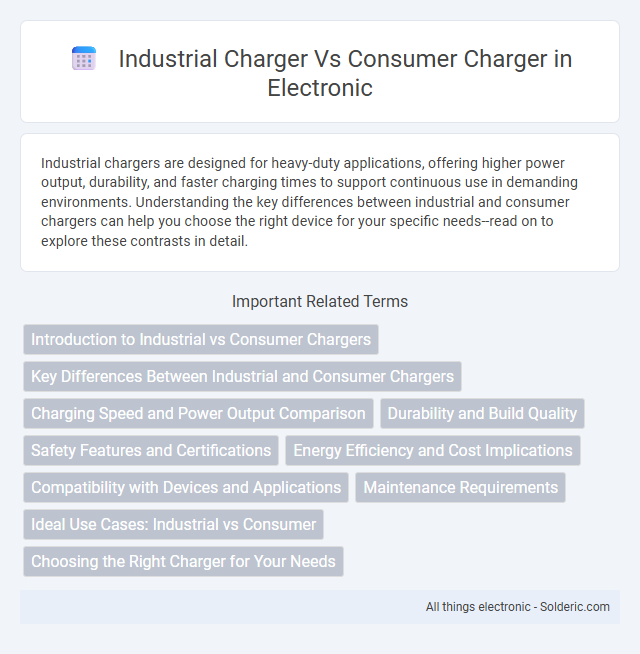Industrial chargers are designed for heavy-duty applications, offering higher power output, durability, and faster charging times to support continuous use in demanding environments. Understanding the key differences between industrial and consumer chargers can help you choose the right device for your specific needs--read on to explore these contrasts in detail.
Comparison Table
| Feature | Industrial Charger | Consumer Charger |
|---|---|---|
| Power Output | High (up to several kW) | Low to Moderate (5W to 100W) |
| Durability | Rugged, built for harsh environments | Lightweight, designed for indoor use |
| Charging Speed | Fast, supports rapid charging | Standard to fast, varies by model |
| Application | Heavy machinery, electric vehicles, industrial batteries | Smartphones, laptops, small electronics |
| Size & Weight | Large and heavy | Compact and portable |
| Cost | High initial investment | Affordable for daily use |
| Safety Features | Advanced, includes thermal and overload protection | Basic to moderate protection |
| Connectivity | Supports industrial protocols (CAN, Modbus) | USB, wireless charging options |
Introduction to Industrial vs Consumer Chargers
Industrial chargers are designed for heavy-duty applications with higher voltage capacities and rapid charging cycles, often used in manufacturing, construction, and logistics equipment. Consumer chargers cater to everyday electronics like smartphones and laptops, emphasizing portability, safety features, and compatibility with various devices. Understanding the differences helps you select the right charger that matches your power requirements and ensures optimal device performance.
Key Differences Between Industrial and Consumer Chargers
Industrial chargers are designed for high-capacity batteries and heavy-duty use, offering robust construction, faster charging speeds, and advanced safety features tailored to demanding environments. Consumer chargers typically target smaller batteries with moderate power output, prioritizing user convenience, portability, and compatibility with everyday electronic devices. The key differences lie in durability, charging efficiency, and adaptability to specific battery technologies within professional versus personal use contexts.
Charging Speed and Power Output Comparison
Industrial chargers deliver significantly higher charging speeds and power output compared to consumer chargers, often providing up to 100 kW or more for fast, heavy-duty applications. Consumer chargers typically range from 3 kW to 22 kW, suitable for everyday use with electric vehicles and small devices. The advanced thermal management and robust electrical components in industrial chargers enable sustained high power delivery without overheating, optimizing efficiency for large-scale operations.
Durability and Build Quality
Industrial chargers feature rugged construction with reinforced casings and high-grade materials designed to withstand harsh environments, heavy usage, and extreme temperatures. Consumer chargers prioritize lightweight and compact designs with less robust build quality, making them more prone to wear and damage over time. The superior durability of industrial chargers ensures longer operational life and reliability in demanding applications compared to consumer-grade alternatives.
Safety Features and Certifications
Industrial chargers often include advanced safety features such as overcurrent protection, thermal management, and robust surge protection to handle heavy-duty and continuous usage environments. They comply with stringent certifications like UL, CE, and IEC standards to ensure operational safety and reliability under harsh industrial conditions. Consumer chargers, while equipped with basic safety mechanisms like short-circuit and overcharge protection, usually meet certifications such as FCC and RoHS, reflecting standards suited for everyday personal use and lower power demands.
Energy Efficiency and Cost Implications
Industrial chargers are designed with higher energy efficiency, utilizing advanced power management systems that reduce energy loss during the charging process, leading to significant cost savings in large-scale operations. Consumer chargers typically prioritize convenience and lower initial cost, resulting in higher energy consumption and increased electricity expenses over time. Investing in industrial chargers can lead to decreased operational costs and improved sustainability for businesses dependent on frequent and prolonged charging cycles.
Compatibility with Devices and Applications
Industrial chargers are designed to support a wide range of heavy-duty batteries and specialized equipment, ensuring compatibility with high-capacity batteries used in forklifts, electric vehicles, and large-scale machinery. Consumer chargers typically cater to standard household electronics, such as smartphones, laptops, and small appliances, providing optimized charging for common battery chemistries like lithium-ion and nickel-metal hydride. The differing voltage, current, and safety requirements make industrial chargers ideal for rugged applications, while consumer chargers prioritize convenience and compactness for everyday use.
Maintenance Requirements
Industrial chargers require regular maintenance including inspection of cooling systems, connectors, and firmware updates to ensure optimal performance under heavy-duty conditions. Consumer chargers typically have minimal maintenance needs, often limited to keeping connectors clean and avoiding physical damage. Understanding these differences can help you choose a charger that aligns with your specific maintenance capabilities and usage demands.
Ideal Use Cases: Industrial vs Consumer
Industrial chargers are designed for heavy-duty applications such as charging large battery packs in commercial vehicles, forklifts, and industrial machinery, offering higher power output and robust durability for continuous use. Consumer chargers are tailored for everyday electronics like smartphones, laptops, and small household gadgets, focusing on convenience, portability, and compatibility with standard power sources. The ideal use case for industrial chargers involves demanding environments requiring fast, reliable charging under harsh conditions, whereas consumer chargers prioritize ease of use and safety for personal and home device recharging.
Choosing the Right Charger for Your Needs
Industrial chargers deliver higher voltage and current output tailored for heavy-duty equipment, ensuring faster and more efficient charging cycles in demanding environments. Consumer chargers prioritize safety features and compatibility with a wide range of personal electronic devices, offering convenience and ease of use. Choosing the right charger depends on power requirements, device compatibility, and intended application, with industrial chargers suited for robust, continuous operations and consumer chargers ideal for everyday electronics.
Industrial charger vs consumer charger Infographic

 solderic.com
solderic.com